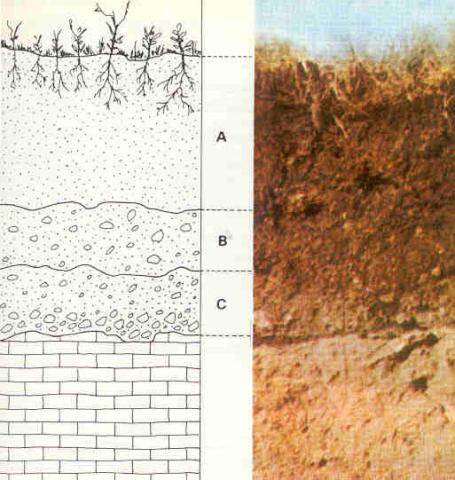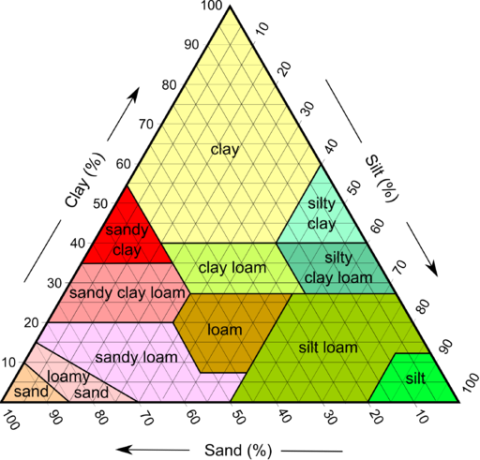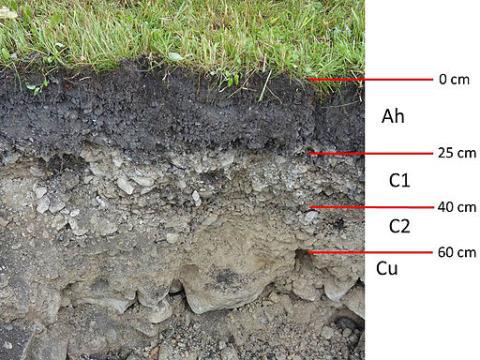Soil is a mixture of mineral and organic matter that contains air, water, and micro-organisms. It provides a medium in which plants grow, a habitat for animals, and storage for water. Many processes take place in soils including the recycling of nutrients, purification of water, and exchange of gases with the atmosphere. Soil is therefore vital to life on Earth.
The mineral content of a soil is derived from a parent material, generally bedrock, that has been modified through time through the action of physical, chemical and biological processes. As bedrock varies greatly from place to place, so do the soils derived from it.
Water plays a major role in this process of soil formation through mechanical fracturing, the dissolution of bedrock, and by supporting biological activity. Of particular note is the freeze-thaw process in which water contained in fissures in the rock freezes and expands causing further fissures to develop. As this freeze-thaw cycle continues, the rock is fractured into smaller and smaller pieces.
In a soil derived from the underlying parent material, a vertical profile down into the ground will reveal this transition from bedrock through unconsolidated rock containing coarse material and stones, to a well weathered soil. These layers within a soil profile are termed horizons. The adjacent figure shows how the soil transitions from parent material at the base to well weathered soil at the surface.

The size of the mineral particles is a key soil property and provides the basis for classification of soils. The largest particles are sand which range from ~50 to 2000 micrometres (1000 micrometres = 1 millimetre). Silt particles are the next smallest particle, typically ~2 to ~50 micrometres; and clay particles are all those particles that are smaller than 2 micrometres. Most are familiar with the size of sand particles, but by way of comparison, silt particles are roughly the size of a typical cell in our body or the thickness of a piece of paper, and clay particles are typically the size of micro-organisms - so extremely small!
Soils are rarely made up of particles of a uniform size, but instead contain a mixture of particle sizes. The combination of different percentages of sand, silt and clay particles is known as the soil texture. As can be seen in the soil triangle below, various combinations of sand, silt and clay have been given names. This classification system uses the term loam to describe a particular combination of the three components.
The range of soil textures can be used as a quick means of assessing possible land uses, for example, a soil that is very high in sand would be excellent for a dune habitat, but retain insufficient moisture for many types of vegetation. A high clay soil might be a good place to site a reservoir because of its low water permeability, as well as a possible source of raw materials for the pottery and brick industry. Loam soils are well suited for most types of agriculture, as they provide a balance of good water retention along with the capacity to drain and not get water logged.
Despite the continuum of different soil types across the globe produced from the unique combination of parent material, weathering and biology, they are able to be classified into a formal classification system. These systems have been developed by practitioners of different trades, such as agriculture, engineering and hydrology, reflecting the varying needs of each profession; in addition, classifications vary by geographic areas, reflecting the influence of different geology and weathering characteristics, for example: Soil Classification for England & Wales, Australian Soil Classification, USDA Soil Taxonomy, and Unified Soil Classification System.

So far we’ve only considered the mineral (i.e., inorganic) content of soils, although we have noted that biological processes influence soil formation and that soil provides a medium for plant growth. Organic matter, i.e. decaying plant and animal material, is incorporated into the soil from the surface, and can form a very obvious layer, horizon, within the soil. Some organic matter will be incorporated deeper into a soil over time through the action of earthworms, roots, animals, and water.
As well as dead organic material, soil will contain living organisms and plant roots. These living things are dependent on the dead organic matter for some of the nutrients they require to survive and grow. In addition the organic matter can greatly improve the water holding properties of the soil. The organic content of soils is therefore as important as the inorganic content. The 'A' horizon, denoted in the adjacent figure, is an example of a high organic soil horizon. Notably, the parent material is immediately below this horizon, making it a relatively shallow, poorly formed (or new) soil.
In temperate climates, an organic layer can easily form a thick, dark, organic horizon at the surface of the soil. The high moisture holding-capacity of organic matter, its potential for retaining nutrients, and its ability to maintain a high microbial community makes soils with moderately high organic content very conducive to growing crops. The highest economic value soils are usually loams forming deep soil horizons allowing for deep root growth and a high organic content. Many soils in tropical climates soils can, paradoxically, be starved of organic matter. Despite high plant litter deposition, the high temperature and wet climate supports a very efficient soil microbial community and mesofauna (small invertebrates), which can rapidly consume and transform decaying plant litter to carbon dioxide and more life. Such soils can often appear red--a symptom of their oxidized iron content--as in the soil profile above, which is devoid of dark organic matter.
In addition to modifying the properties of inorganic soils, some soils (peats) are composed entirely of decaying plant matter. Peat is usually waterlogged and lacking in oxygen which prevents, or slows, the process of decomposition so that over long time periods deep peat soils can develop. The unique conditions that create peat soils is also why they are so prized and in need of protection.

Finally, let’s reflect of the time taken for soils to develop. Soils are in a constant state of aging and reflect tens, hundreds, thousands and sometimes tens of thousands of years of development. Much of the northern hemisphere acquired some of its soil from the action of glaciers physically grinding rock over periods of thousands of years. These glacial sediments, glacial till, can be dated to the last big glaciation which started 110,000 years ago and ended about 15,000 years ago. By contrast, soils deposited from the air via wind (i.e. dust storms) or by water (i.e. floods), might be many orders of magnitude more recent than soils of glacial origin.
With each successive flood, comes the deposition of river sediment, usually high in silt and clay and thereby making soils on floodplains conducive to agriculture. This mechanism of soil formation helped support the growth of many ancient and modern civilizations including Mesopotamia (Tigris & Euphrates), China (Yangtze), Egypt (Nile) and North America (Mississippi).
Next: What is soil moisture?
Photographs were sourced from the Wikimedia Commons. Any credit/attribution can be found by clicking on the photo.
